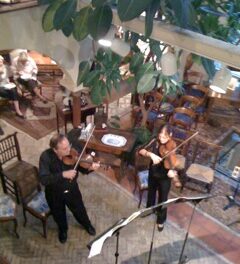Opera House Theatre Company has been presenting theatre in Wilmington for over 35 years. It offers a fruitful collaboration of local and professional talents. Here in Wilmington, our local performers are often full-fledged professional talents themselves.
Historic Thalian Hall has been the company’s home from the beginning. Their current production is a fine revival of the musical Funny Girl, a dynamic, touching, semi-fictionalized account of the life of Fanny Brice. Brice (1891-1951), born in New York City, was a singer, actress, and comedienne. She headlined the renowned Ziegfeld Follies for two years. She became especially known as a singer for the song “My Man,” which could be regarded as her signature piece. From the 1930s she was a well-known radio personality, playing the toddler Snooks in a weekly program. Last broadcast in 1951, some of our older readers might have even listened to this show at the time. Today, Brice has two stars on the Hollywood Walk of Fame.
Many among our readers are probably familiar with the now-iconic film about Brice starring Barbra Streisand and released in 1968. Four years before that, Funny Girl, with Streisand as Fanny Brice, was a Broadway hit, running for over three years (though Streisand didn’t appear for all of that time). This is where Streisand first performed one of her most famous songs, “People.” Brice and Streisand shared strong personal similarities – including but not limited to being Jewish, part of Brice’s persona in portraying her on the stage. The two artists performed and partly rose to fame, 50 years apart, in places in New York that are within blocks of one another.
As this is being written, Funny Girl is having a revival both in Wilmington and on Broadway; in New York it has been playing since April of this year. Here it is being given eight performances over a period of two weeks.
Opera House Theatre Company is a troupe whose members possess both dramatic and musical strength. ( The artistic team and cast bios can be are shared here in the program notes.)Fanny Brice is the dominating character in this piece, being onstage for most of the time, and leading many of the musical numbers. She was played by Kendra Goehring, a North Carolina native who trained both here in North Carolina and in England. Goehring is an Opera House mainstay, having performed in many of the group’s productions.
One experienced her here as a performer, in this sense like Brice and Streisand before her, with an infectious love for the stage. She can sing, dance, and act. Her dance numbers had verve and snap. Her movements were very flexible, which made her funny as well. Her portrayal of Brice’s character ranged from a humorful depiction of a naïve New York girl – who knows more than it looks like she does – to nuanced dramatic responses as the story unfolded. Her singing, given the substantial musical numbers in the piece, carried weight and expression, as well as sometimes humor.
She had a worthy dramatic partner in Jon Berry, who played the sometimes-wealthy ne’er-do-well Nic Arnstein. He was replete with elegance; one felt, as Fanny did, that her future husband was a person of class. There were affecting scenes between them as, despite all that happened, they still deeply loved one another.
Fanny’s mother, played by Holli Saperstein, gave a convincing portrait of the perhaps-classic loving, gushing, pushy, sometimes-critical Jewish mother. The famous Florenz Siegfeld was played with shifting, sometimes funny reactions by Steve Hassmer. He had a mercurial star performer to deal with, and the two butted heads well. (Florenz, pronounced FloRENTS and in the play shortened to the female “Flo,” had a German immigrant father; he was born in Chicago).
The rest of the supporting cast was successful. There was energetic chorus dancing and singing, and an enjoyable poker quartet. The sets, designed by Terry Collins, were strong. They gave visual variety and color, and sometimes changed with elaborate layering. (A nice touch was the Mazel Tov sign at the celebration party after Fanny’s big premiere.) The costumes, designed by Debbie Scheu, contributed more color and gave the characters individual visual personality. (One had to see the crazy hats in one of the show scenes). The numerous, sometimes-extensive dance numbers were also colorful and filled with energy. The pit band of a dozen accompanied strongly, adding pizzaz and character to the onstage events.
The song selection was the same as in the original 1964 production; in this it is not like the current Broadway revival, which adds several songs. None of the productions have included “My Man”, the song Brice was so well-known for.
The sound quality was a drawback in this picture of excellence. The performers were heavily amplified, to the point of making the sound somewhat artificial. If amplification is seen to be needed for these professional actors and accomplished singers, perhaps it should be significantly reduced. In the songs, the tone tended to become hard when the voices rose above about an A, and when reaching a louder volume. This in turn affected the expressive quality of the music – good as it also was.
One also wondered about the broadly-drawn humor in Fannie’s earlier scenes. Yes, she was a feverishly-driven, incandescent personality striving for the stage. But she was also portrayed in her offstage persona as a vaudevillian, which perhaps unnecessarily exaggerated this aspect of her individuality. She was also played with a broad New York accent (not to say a Brooklyn accent, as she was born and raised in Manhattan) which again may have overplayed this aspect, especially as later in the piece, the accent diminished very noticeably.
That said, this was an excellent and entertaining evening at the theatre, enthusiastically received by the audience, filled with fine music, emotions one believed in, and visual energy. One hopes that the decent attendance of last night will become a full house!
This performance repeats through Sunday, September 11. See our sidebar for details.











